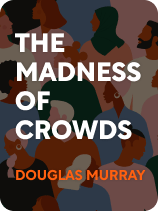

This article is an excerpt from the Shortform book guide to "The Madness of Crowds" by Douglas Murray. Shortform has the world's best summaries and analyses of books you should be reading.
Like this article? Sign up for a free trial here.
Does it seem like the world has gone mad? What accounts for the recent sweeping societal changes, and is there a way out?
In The Madness of Crowds: Gender, Race and Identity, Douglas Murray argues that Western society is currently consumed by an ideology that’s obsessed with social justice and identity politics. He discusses the roots of this change, its impact, and a potential remedy.
Continue reading for an overview of this timely book.
Overview of The Madness of Crowds: Gender, Race and Identity
In his book The Madness of Crowds: Gender, Race and Identity, Douglas Murray contends that the West is swept up in an ideology that’s fixated on social justice and identity politics. (For clarity and consistency, we’ll call this ideology the New Ideology.) New Ideology insists that certain groups in society (notably women, racial minorities, and LGBTQ+ individuals) endure widespread prejudice and oppression that go back centuries. It further argues that these groups should receive sensitivity, accommodations, and apologetic behavior from the social majority—particularly white men—to compensate for their suffering.
Murray further contends that the New Ideology has become so mainstream that it’s virtually impossible to challenge it without suffering public ridicule and shaming. It functions like a religion—one that everyone in society is increasingly being compelled to follow. Murray argues that, if we don’t combat the New Ideology, restore a constructive space for civic disagreement, and depoliticize our personal identities, our society will become even more fragmented and chaotic, and conceivably violent.
Murray is a journalist and political and social commentator who serves as assistant editor for The Spectator. He’s also the author of several bestsellers, including The Strange Death of Europe, and he features on conservative TV shows and podcasts, speaking on topics such as threats to free speech and the decline of European identity.
We’ll examine the following:
- The New Ideology being a fusion of three interrelated phenomena: wokeism, intersectionality, and identity politics
- The historical, social, and intellectual developments that influenced the New Ideology
- The New Ideology’s primary effects on society and the consequences Murray predicts if we don’t act to reverse these trends
- The possible remedies Murray suggests for this predicament
| Wokeism and Protestantism Others agree that aspects of the New Ideology—particularly wokeism—resemble religious devotion. Some commentators believe wokeism resembles elements of Protestant Christianity, due to wokeism’s tendency to: Seek moral perfectionism—like how early Protestant churches sought to perfect or reform the medieval Catholic Church and bring the rest of society into line with these teachings Engage in “witch hunts” for those who challenge the ideology’s view or endanger the salvation of the group—as Protestants did during the Salem Witch Trials of 1692 Reject institutional or traditional authority—like how early Protestants rejected the papacy Consider those who are woke to be a sort of elect (those visibly chosen by the Divine) who can then dictate morality to the unrighteous—like how many Calvinist-inspired Protestant denominations believe in the concept of an elect being predetermined to salvation |
Defining The New Ideology: Wokeism, Intersectionality, and Identity Politics
Let’s first define the three main pillars of the New Ideology: wokeism, intersectionality, and identity politics. We’ll discuss all three pillars in detail, as well as offer a brief introduction to why Murray believes each one is flawed.
The First Pillar: Social Justice and “Wokeism”
The first pillar of the New Ideology is hyper-concern with social justice, as seen through the phenomenon of wokeism. To be “woke,” in its most basic sense, means to be keenly aware of instances of social injustice (for instance, racism or sexism) and to be on guard against them. However, Murray argues, modern wokeism has become more extreme and intolerant. It now sees any conceivable slight against members of minority groups as evidence of widespread oppression. It also encourages both a mob-like mentality and a sense of moral superiority in villainizing and shaming anyone who disagrees with wokeist ideas.
According to Murray, wokeism encourages people from the dominant social class (namely white people) to offer public displays of atonement for perceived injustices against minority groups. For example, a white person might apologize to a Black person for enjoying white privilege (in other words, for experiencing social, economic, and other advantages due to society being inherently racist toward non-white people). They might give this apology despite not being responsible for the race they were born into, and despite civil rights legislation largely erasing, Murray argues, any systemic advantages for white people.
Murray also argues that public displays of atonement like the one described above usually aren’t genuine, empathetic reactions to the traumas minorities have experienced. Instead, they’re often disingenuous gestures meant to protect the person giving the apology from public humiliation, or to help that person to ingratiate themselves with the minority group for personal gain.
The Second Pillar: Intersectionality
The second pillar of the New Ideology is intersectionality. This theory again argues that multiple groups within society—particularly women, LGBTQ+ people, and racial minorities—suffer consistent, systematic oppression. It also states that certain people might fit into more than one category of marginalized identity (for example, they might be both Black and LGBTQ+) and thus experience overlapping discrimination.
Murray believes intersectionality’s supporters falsely insist that the more discrimination a person experiences, the better they understand how oppression functions in society, thus making them capable of superior moral insights into how to fix it. Further, intersectional activists argue that because marginalized groups share similar circumstances, they also share solidarity with each other in achieving emancipation from oppression. In working to free itself, each group helps liberate the others and thus removes oppression from society in general. Murray argues the contrary: that these groups often have contradictory and even antagonistic aims.
The Third Pillar: Identity Politics
The third pillar of the New Ideology is identity politics. Murray explains that this involves individuals, particularly those belonging to minority groups, considering that minority identity to be their most important political and social attribute. Aligning with the interests of that minority group—and battling perceived oppression of it—becomes the primary way they engage in politics. This creates a divisive us-versus-them mentality that makes society more fractious and combative—each group is predominantly concerned with its own interests at the expense of others’ interests.
The Causes of the New Ideology
Now that we’ve covered the basics of the New Ideology, let’s examine how it’s gained a foothold in mainstream society. We’ll start with major societal shifts that Murray believes influenced these ideological changes, including the declining influence of orthodox religion, the rise of secular ideas, and the diffusion of interests that gave rise to smaller identity groups. We’ll then look at the influence of academic ideas. Finally, we’ll briefly cover how certain economic and technological shifts contributed to the ideology’s growth.
The Demise of Traditional Religion and Liberalism
First, Murray argues the New Ideology partly developed due to the decline of several major belief systems that previously stabilized Western society: most notably, traditional religion and traditional liberalism. These two belief systems offered society stability because they gave life meaning through big-picture explanations of how the world works. Traditional religion argued that divine planning shaped events. Liberalism argued that human reason (our ability to seek and reveal truth through the use of intellect, logic, and observation), and our corresponding ability to improve the world, was the most impactful force.
In the 19th century, traditional religion and major political ideologies like liberalism increasingly lost their credibility. According to Murray, the resulting vacuum was then filled by postmodernism. This intellectual and artistic movement argued that universal truths and movements that forward them are untrustworthy, and that the human condition is instead prone to ever-more fragmented varieties of experience.
Ultimately, Murray concludes, these ideological shifts drove people to find new forms of meaning. Many did so by identifying with smaller and smaller groups based on immutable characteristics like race, gender, and sexual orientation. Eventually, the act of fighting to protect these groups from perceived victimization appeared to offer a new, higher morality to replace those that religion and liberalism previously provided.
The Influence of Marxism
Murray also believes that leftist academia, particularly Marxism, influenced the rise of the New Ideology. Marxism, developed by Karl Marx, argues that economics, particularly the control of resources, is the major driving force behind how human society functions (and has always functioned). This drives the development of a social structure in which one class dominates most of the resources and uses the labor of the less powerful classes to cement its power.
Marx thought that capitalism—wealthy industrialists owning most businesses and exploiting the labor of manual, hourly workers (also called the Proletariat or working class)—would be the final stage of this abusive pattern of history. Eventually, the oppressed working class would rise up against the dominant one, ending abuse, inequality, poverty, and corruption.
While traditional Marxism believes in the need to free working-class laborers from economic oppression, Murray thinks the New Ideology promotes a slightly different brand of cultural Marxism—one that prioritizes the freeing of minorities from social oppression instead. Further, rather than evenly redistributing economic resources across all walks of life as traditional Marxism desires, the New Ideology wants to redistribute social and political influence. It provides activists with the tools to achieve this through the three pillars of intersectionality, identity politics, and wokeness.
The Impact of the Great Recession
Murray notes that the Great Recession of the late 2000s also contributed to the rise of the New Ideology. This economic crisis ruined the faith many younger adults held in capitalism by dashing hopes that they could ever achieve the financial independence of their parents. Murray believes that this experience prompted many young adults to feel drawn to the New Ideology, which is overwhelmingly concerned with correcting every perceived form of inequity.
The Impact of Social Media
Murray also contends that social media has made it easier for the New Ideology to flourish. This is because people use online spaces to constantly express feeling offended by perceived slights to their beliefs and identities.
Murray elaborates that social media encourages people to hyper-focus on themselves and their experiences. When they feel aggrieved by an offense, they can instantly vent that frustration on social media, or even call out the person they think is guilty of that offense. Like-minded people can then react immediately and virally, creating a toxic environment. Further, these like-minded users rarely examine the original circumstances of the incident to either prove or disprove the accusation. This can then lead to cancel culture, which we’ll discuss very shortly.
Finally, Murray notes that social media has become a means through which politicians, academics, media personalities, and others aligned with the New Ideology can police speech and ideas not aligned with it. They censor and condemn those who express these ideas.
Impacts of the New Ideology
Now that we’ve explored the key ideas of the New Ideology and how they achieved widespread recognition, let’s examine what Murray believes to be two of its most egregious effects: harming free speech, and creating contradictions that cause societal and psychological harm.
Impact #1: Harming Free Speech Through “Cancel Culture”
Murray argues that the New Ideology is harming free speech by trying to force consensus where it doesn’t exist and punishing those who don’t conform. Its adherents decide certain viewpoints on issues such as trans rights and racism are objectively correct, and they demonize alternative opinions. Anyone who dares to offer a contrary opinion risks being subject to “cancel culture”: public ridicule and the possible collapse of their reputation, career, and livelihood. Cancel culture harms free speech and prevents discussion around significant issues that deserve open debate.
Let’s examine two examples of this curbing of free speech.
Example #1: Silencing Conservative Viewpoints
First, Murray argues that the New Ideology’s tendency toward censorship makes it difficult for people with conservative views to voice their opinions on hot-button issues like race, homosexuality, and transgenderism for fear of provoking public outrage. Public attitudes have rapidly become more favorable toward topics like women’s empowerment and LGBTQ+ rights, which has left many social conservatives feeling left behind and like their values are threatened. However, due to cancel culture, conservatives no longer feel able to voice this feeling.
Example #2: Masking a Lack of Scientific Consensus
Another area in which the New Ideology is harming free speech is in scientific discussions. Murray argues that science hasn’t corroborated many of the core assumptions now associated with Leftist views of certain topics, but the New Ideology presents these assumptions as settled facts. Because of this, debate around these topics is quashed—the threat of cancel culture silences any opinion inconsistent with the New Ideology. However, Murray believes that many of these topics still deserve rigorous public debate due to the true lack of scientific consensus surrounding them.
According to Murray, a topic suffering from this issue is whether or not homosexuality is a fixed state of being. The New Ideology believes that homosexuality is a fully natural, immutable feature of a person’s identity, and it argues that denial of this is an act of discrimination. However, Murray points to recent statements from both the Royal College of Psychiatrists and the American Psychological Association that indicate a lack of consensus on this issue. Instead, it seems there’s still debate about whether same-sex orientation is a product of nature or nurture, and whether it’s a permanent fixture of identity or something that can be changed.
Another topic that, in Murray’s view, deserves more scientific discussion is transgenderism. He notes that gender-affirming surgery and hormone therapies may damage individuals’ long-term health—for instance, by causing irreversible sterility. However, parents of transgender children are often discouraged or intimidated from asking questions about these effects for fear of damaging or worsening their children’s mental states.
Finally, Murray also views bias tests, such as the Implicit Association Test (IAT), as scientifically problematic. These tests aim to uncover unconscious biases in the subject, such as acceptance of harmful racial stereotypes. Murray notes that there’s a lack of empirical consensus on these methods’ accuracy. However, they’ve still encouraged a neurotic tendency for white people in particular to suspect themselves of prejudices they likely don’t have, as well as triggering guilt over participating in systemic oppression against minorities that doesn’t exist.
Impact #2: Creating Harmful Contradictions
Murray argues that as well as threatening free speech, the New Ideology presents contradictions that can cause psychological or societal harm. Let’s examine a few examples of these contradictions.
Example #1: Intersectionality Doesn’t Equal Solidarity
According to Murray, one contradiction lies in a basic premise of intersectionality: that all oppressed groups share common interests. Instead, these interests conflict far more often than they align, producing greater friction and divisiveness. The idea that society is rife with oppressed groups inevitably leads to certain groups imagining themselves as more oppressed than others. If one group feels more oppressed than another, it considers itself entitled to more concessions and attention, creating conflict with other oppressed groups.
Murray gives the example of a Cornell University activist group named Black Students United. In 2017, the group argued that the university should favor Black students of multi-generational US descent—in other words, the descendants of enslaved people—over Black students whose families had emigrated more recently. In this case, there was divisiveness within a single racial identity.
Example #2: Undoing the Principles of Civil Rights
Murray also believes that although adherents to the New Ideology think they’re promoting equality, they’re actually undoing important civil rights accomplishments—especially those regarding minorities’ right to be judged on merit and achievement rather than their minority identities.
Dr. Martin Luther King, Jr. believed being judged according to merit was central to truly seeing a person’s talents and potential. However, Murray argues that the New Ideology, through practices like diversity hiring and affirmative action, has reverted to a focus on attributes like race, gender, or sexual identity, which have nothing to do with a person’s intrinsic abilities or experience.
Example #3: Sexuality Versus Sexualization
A final example applies to contemporary feminism, which Murray contends liberates women to act in increasingly sexualized ways, such as in pop music videos, films, and media appearances. Yet, the New Ideology doesn’t allow men to respond to this erotic material in any way that could be construed as sexually objectifying women. This sends mixed messages to men who are simply trying to determine what healthy heterosexual expression actually is, leaving them feeling discouraged, confused, and frustrated.
What if We Can’t Fix This?
Murray predicts serious consequences for our civilization if we’re not able to effectively stem the tide of the New Ideology. Let’s explore two of these effects: societal shame and the increased risk of violence.
Consequence #1: Societal Shame
The first result of not stemming the New Ideology will be the continued prevalence of feelings of guilt, sin, and shame in society. Murray argues that the ideology is always concerned with assigning blame and reliving traumas of the past, leading to these negative emotions. He contends that our society is even less capable of handling these collective emotions now that traditional religion is weaker. Traditional religion at least offered us a means of using redemption, forgiveness, and love to overcome negative emotions.
Consequence #2: Widespread Violence
Another of Murray’s concerns is that the New Ideology’s obsession with uprooting privilege will escalate chances for large-scale violence. He specifically cites acts of violence and vandalism that occurred in connection with the Black Lives Matter movement (BLM). Murray also expresses concern that such acts will become increasingly common, masquerading as calls for justice (such as justice for George Floyd) when they’re really calls for vengeance against the perceived white majority, Western culture, and historic discrimination. He explains that the blame-casting call of the New Ideology feeds this vengeance.
For Murray, violence from believers in the New Ideology may ultimately lead to the majority white population retaliating against the oppressive, totalitarian nature of the New Ideology. He fears that these retaliators will believe minority identity groups are responsible for the New Ideology, and these retaliators will target these groups for reprisals. This could set the clock back on many of the hard-fought rights that minority groups have achieved in recent decades. Murray thinks it’s possible that when the majority retaliates, it may use what it sees as similar methods of censorship, humiliation, and villainization.
Remedies for a Healthier Society
Murray offers several strategies for reducing the influence of the New Ideology. Let’s examine two: finding meaning outside politics, and gaining perspective on issues of discrimination.
Strategy #1: Find Meaning Outside of Politics
The most urgent of these strategies is to diminish the role of politics and its ensuing competitiveness in our lives. By this, Murray doesn’t mean that you should stop being interested or active in politics. This is part of who we are as human beings, and democracy is all about individuals participating.
Rather, Murray argues that we need to stop using politics as a way to find meaning in life—in other words, we should stop making every element of life political and fighting so-called oppression and injustice. Specifically, we must eschew politics in its current form—rife with toxic competition and conflict, much of which stems from the influence of the New Ideology. We should seek meaning in healthier areas of life—for instance, in our personal relationships with family, friends, and spouses.
Strategy #2: Gain Perspective on Issues of Discrimination
Murray also suggests that we should think about occurrences of injustice in our society with a sense of proportion. He argues that, even though discrimination still exists in Western society, it’s far less prevalent or acute than it was in the past. Further, in other regions of the world, minority rights lag dramatically behind where they are in the West. Therefore, while we still have some work to do in fully removing bias and unfairness from our society, we should be grateful for the progress already made.
Exercise: Reflect on The Madness of Crowds
Reflect on the ideas about wokeism, intersectionality, identity politics, and society presented in The Madness of Crowds.
- Murray explains that woke “cancel culture” harms freedom of speech and leads to conservatives being ridiculed and deplatformed. Do you agree that cancel culture operates in this way? Why or why not?
- Murray also discusses intersectionality: the idea that people can experience more than one type of discrimination, and that certain groups of people are more oppressed. Explain your perspective on this concept: Do you believe it accurately represents different groups’ experiences of oppression in modern society? Why or why not?
- Reflect on the concept of identity politics: individuals, particularly those belonging to minority groups, considering their identity to be their most important political and social attribute. What elements of your identity influence your political beliefs, and why?
- Consider Murray’s solutions for detoxifying society. Do you agree that these practices would lead to a healthier, less divided society? Explain your answer.

———End of Preview———
Like what you just read? Read the rest of the world's best book summary and analysis of Douglas Murray's "The Madness of Crowds" at Shortform.
Here's what you'll find in our full The Madness of Crowds summary:
- That Western society is consumed by social justice and identity politics
- Why we must combat this ideology and restore opportunities for disagreement
- How conservative viewpoints are being silenced and possible remedies






